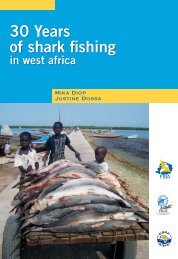Kyne & Simpfendorfer.. - Shark Specialist Group
Kyne & Simpfendorfer.. - Shark Specialist Group
Kyne & Simpfendorfer.. - Shark Specialist Group
You also want an ePaper? Increase the reach of your titles
YUMPU automatically turns print PDFs into web optimized ePapers that Google loves.
SECTION III.<br />
DEEPWATER CHONDRICHTHYANS AND FISHERIES<br />
There is a general lack of available trade and landings data for deepwater chondrichthyans<br />
(Cavanagh and <strong>Kyne</strong> 2005). Indeed, statistics are often lacking for catches of sharks, rays and<br />
chimaeras in general. Globally, the chondrichthyan fishes represent approximately 1% of total<br />
fisheries production (Bonfil 1994), although the reported catch has been increasing over the<br />
past three decades (Stevens et al. 2000, FAO FIGIS database). Many deepwater species are<br />
taken as bycatch, often discarded, or landed under generic species-codes such as 'shark' or<br />
'other'. It has been suggested that 50% of the world's catch of chondrichthyans is taken as<br />
bycatch (Stevens et al. 2000) and while Bonfil (1994) suggested that the actual annual catch<br />
of chondrichthyans may be twice as high as the reported catch, Clarke et al. (2006) postulated<br />
that the biomass of shark involved in the shark fin trade is 3–4 times higher than reported<br />
catch statistics indicate.<br />
As traditional marine resource stocks are depleted, global demand for fish products increases<br />
and fishing technology advances, fisheries are moving into deeper water and new commercial<br />
deepwater fisheries are continuing to develop (Gordon 1999, Lack et al. 2003, Morato et al.<br />
2006). The lack of accurate catch data, including the under-reporting of catches, the lack of<br />
recording bycatch, poor taxonomic resolution and species-identification, and illegal fishing,<br />
makes an assessment of the global catch of deepwater chondrichthyans extremely difficult.<br />
This Section reviews available fisheries data on deepwater chondrichthyans utilizing FAO<br />
(the United Nation's Food and Agriculture Organization) fisheries statistics to overview trends<br />
in global and regional production of deepwater chondrichthyans. There are considerable<br />
limitations to this data and these are discussed in this Section. Additionally, a number of case<br />
studies are presented covering southern Australia, the Northeast Atlantic, the Azores, the<br />
Maldives and Namibia. For some of these case studies, actual catch data is not available, but<br />
they are discussed to demonstrate a collapse in a deepwater shark fishery (Maldives) and<br />
approaches to the precautionary management of a developing deepwater shark fishery<br />
(Namibia).<br />
GLOBAL PRODUCTION OF DEEPWATER CHONDRICHTHYANS, 1950-2004<br />
Status: Increasing but fluctuating trend in global production. Poor data resolution and<br />
under-reporting make this analysis of questionable accuracy, and together with bycatch<br />
issues and illegal fishing, make an assessment of global trends extremely difficult.<br />
The FAO FIGIS database provides global production statistics for fish and other living marine<br />
resources for the years 1950 to 2004. Data were extracted for production statistics of all<br />
'deepwater' chondrichthyans, that is for species or species groups that are listed in Section I of<br />
this report (annotated checklist of deepwater chondrichthyans). Table 3.1 outlines the FAO<br />
database categories and their corresponding scientific names that were used in this analysis.<br />
Global and regional (by major ocean region) production figures are presented for 1950–2004<br />
for all deepwater species categories combined. The major ocean regions used are based upon<br />
the FAO's Major Fishing Areas for Statistical Purposes as outlined in the introduction of<br />
Section I of this report. Data for major ocean regions were compiled by extracting data for all<br />
121
















